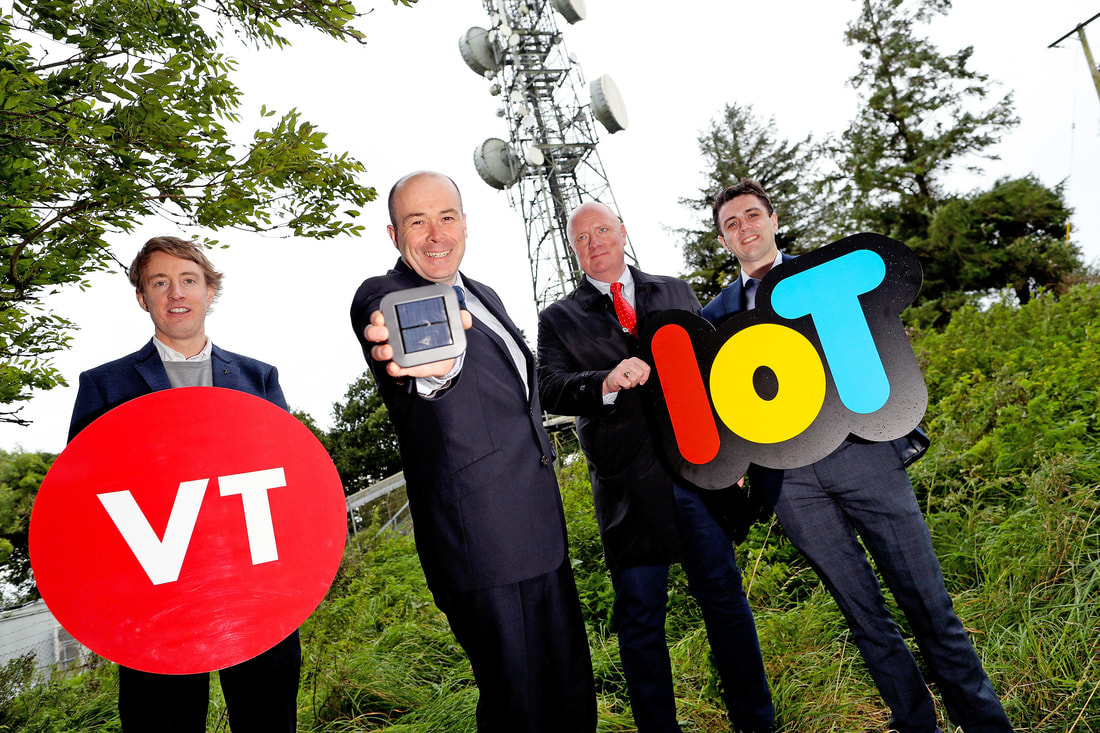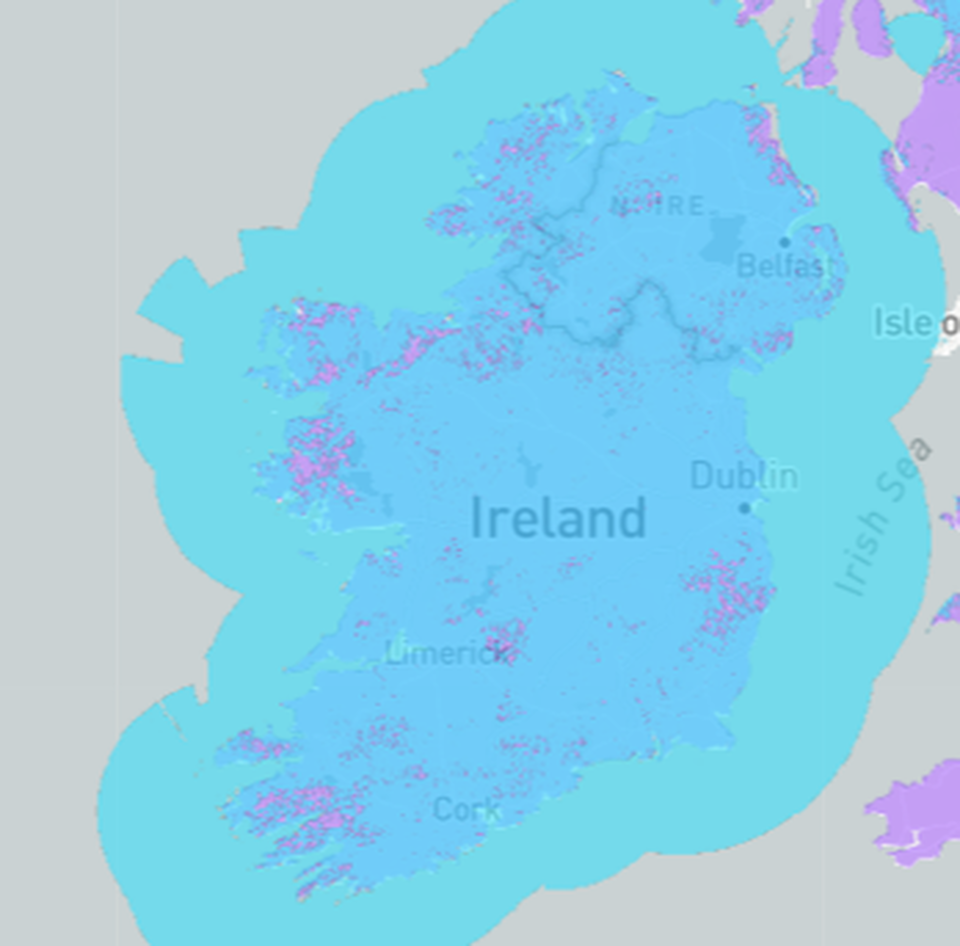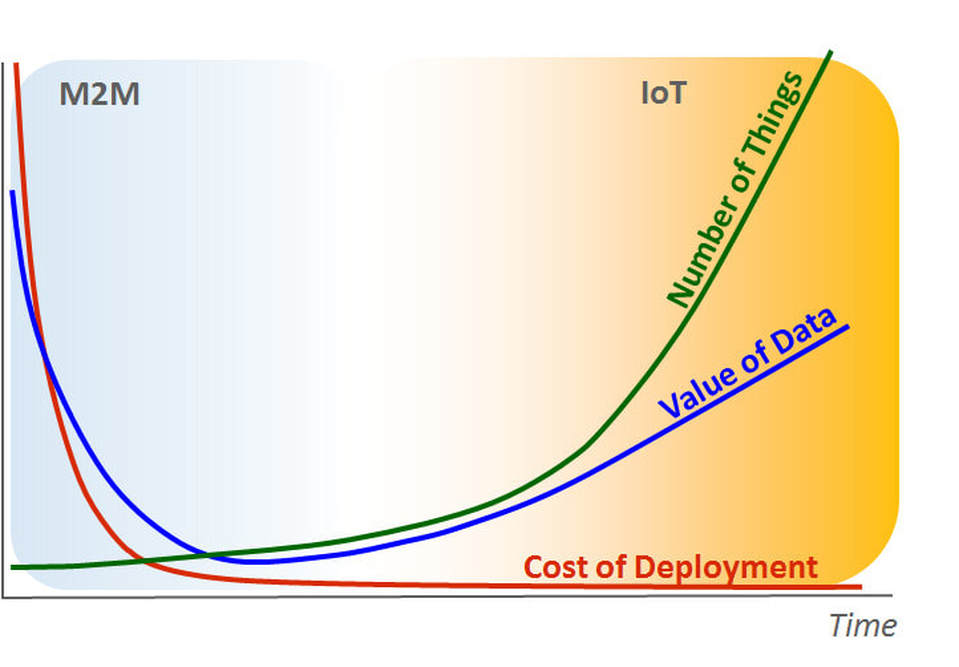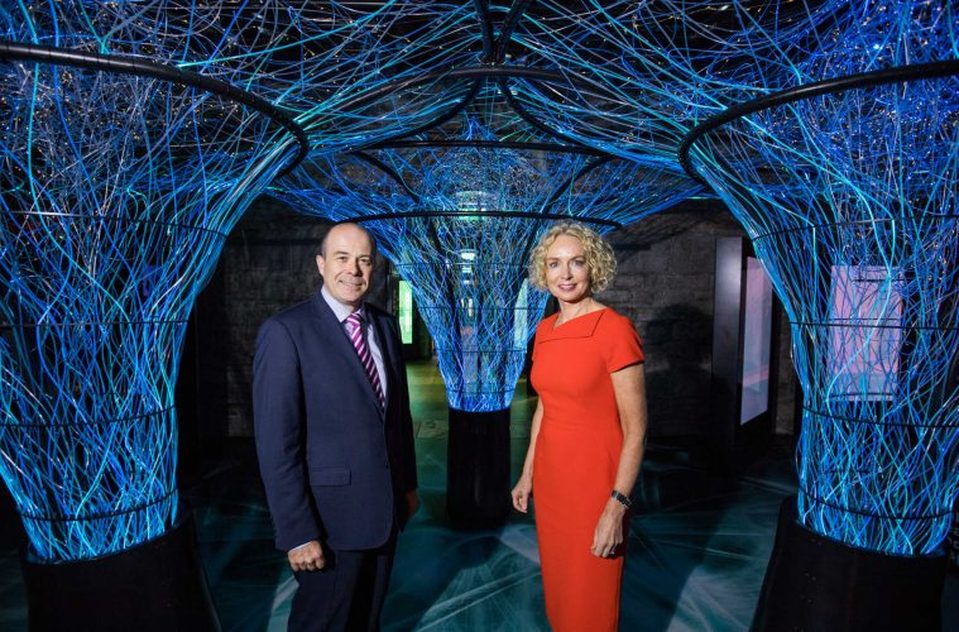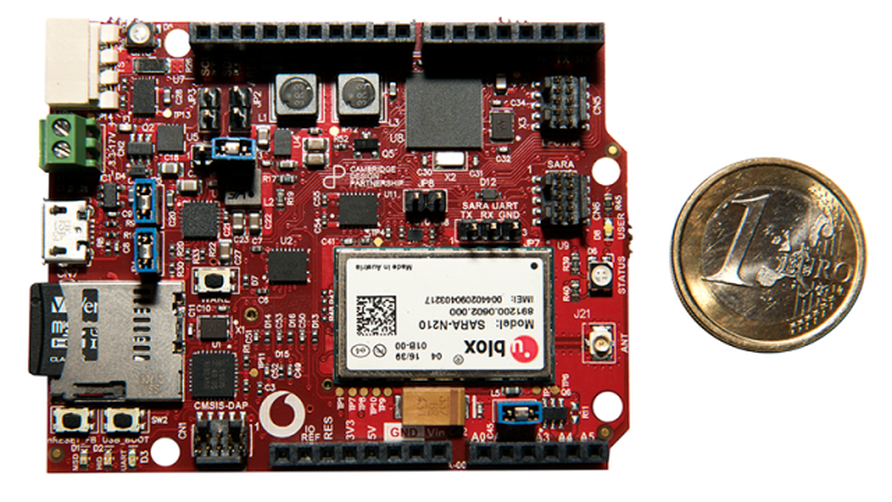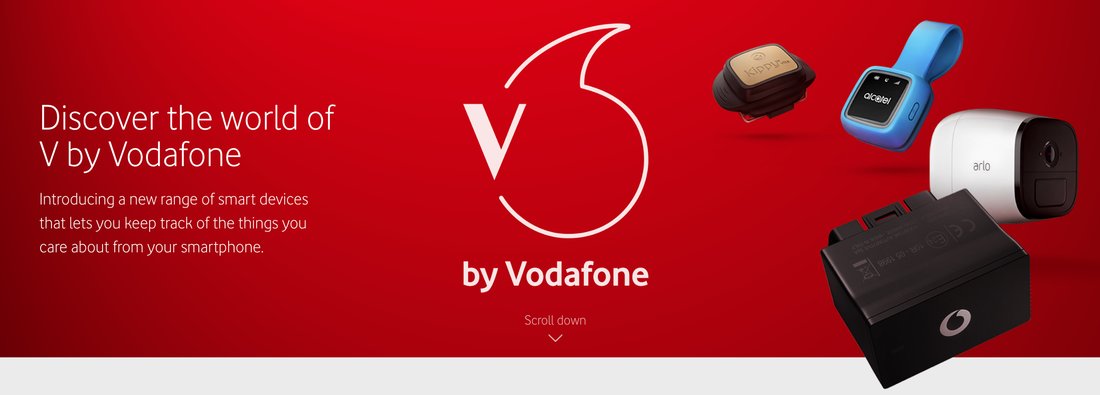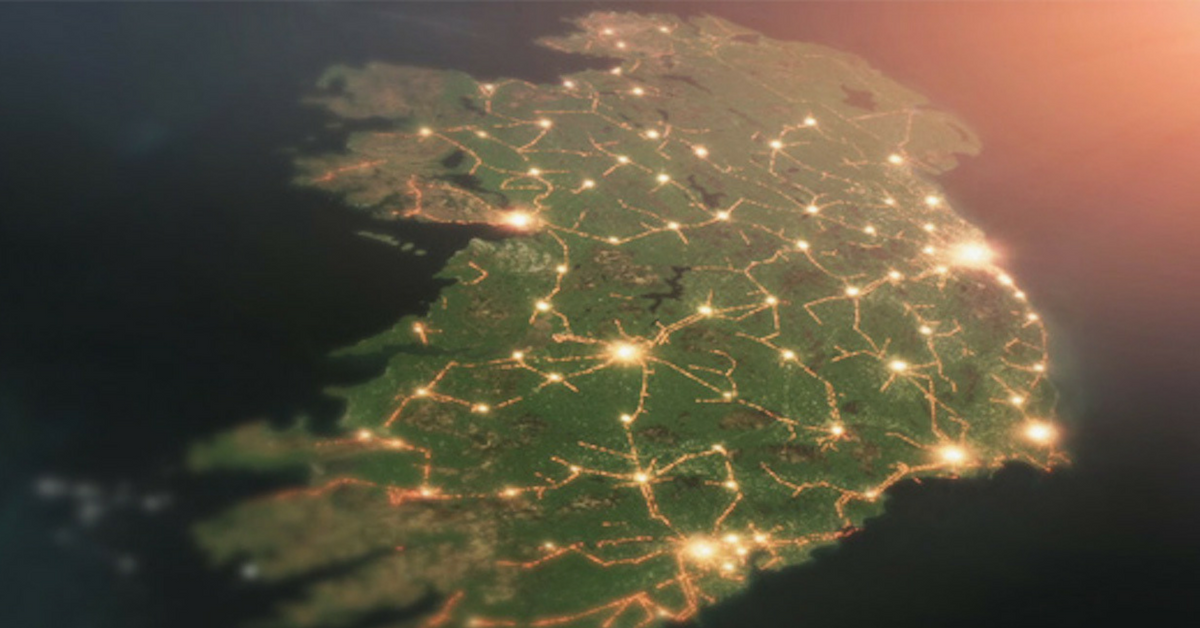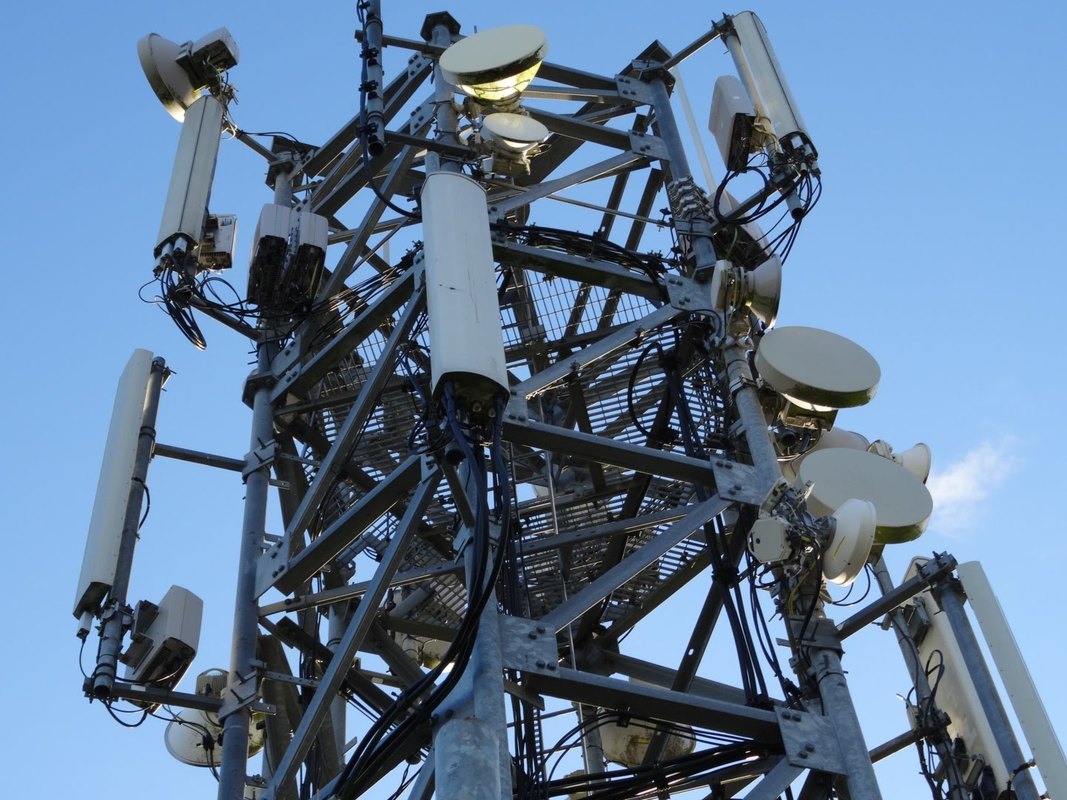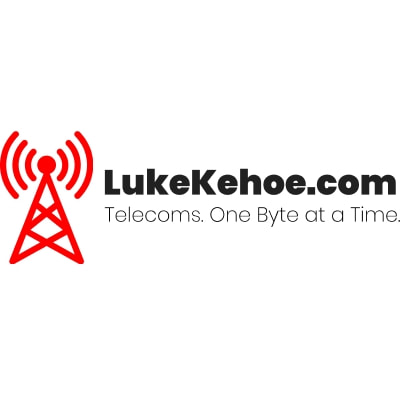The State of the IoT in Ireland
Ireland is leading the charge to a connected future in which data is the new oil.
Published 10/11/18
On a small island in the Atlantic ocean, a population of innovators and visionaries are laying the foundations for a connected society of the future. Toiling together, day and night, the idea of an Internet of Things is on the verge of breaking free from just that: it's no longer an idea, it's a reality.
A rich ecosystem of networks, devices and services are beginning to sprout up across the island, and the realisation that the Internet of Things will truly revolutionise entire industries is popping into the minds of more and more people, day after day, byte after byte.
Just as an ecosystem of plants would wither without interdependence, the same premise exists with the Internet of Things. One component of the technology is dependent on another, and growth is unachievable without all the parts present and working in tandem to facilitate what the Internet of Things is all about: data.
All of those components are beginning to mesh together, from developing the networks that support the devices to evolving the sensors that beam the data back to the cloud. There is still a lot of work to be done in the realms of cost, fragmentation and security, but we are now at the point where the Internet of Things is entering and enhancing the lives of ordinary, everyday people and their businesses. Rome wasn't built in a day, and neither will an Ireland of connected things.
Let's discover and explore how the many individuals and companies in Ireland, no matter how large or small, are leading the charge to a connected future in which data is the new oil.
A rich ecosystem of networks, devices and services are beginning to sprout up across the island, and the realisation that the Internet of Things will truly revolutionise entire industries is popping into the minds of more and more people, day after day, byte after byte.
Just as an ecosystem of plants would wither without interdependence, the same premise exists with the Internet of Things. One component of the technology is dependent on another, and growth is unachievable without all the parts present and working in tandem to facilitate what the Internet of Things is all about: data.
All of those components are beginning to mesh together, from developing the networks that support the devices to evolving the sensors that beam the data back to the cloud. There is still a lot of work to be done in the realms of cost, fragmentation and security, but we are now at the point where the Internet of Things is entering and enhancing the lives of ordinary, everyday people and their businesses. Rome wasn't built in a day, and neither will an Ireland of connected things.
Let's discover and explore how the many individuals and companies in Ireland, no matter how large or small, are leading the charge to a connected future in which data is the new oil.
The Networks making the IoT a Reality, Today.
VT IoT operates the largest dedicated Internet of Things network in Ireland, making low-cost, long-lasting and versatile IoT deployments a reality.
VT IoT holds an exclusive license to operate the Sigfox network in Ireland, and its presence has, undeniably, acted as a catalyst for growth in the Internet of Things industry here. But don't take my word for it, I'll hand you over to Will Ferguson, Co-Founder and COO at VT IoT, for a minute to explain what Sigfox actually is.
"I’m one of the founders of VT. The company was set up by myself and Mark Bannon four years ago. VT is the Sigfox IoT network operator in Ireland. Sigfox is the world’s leading Low Power Wide Area Network (LPWAN) built to collect small messages from billions of devices in the physical world. It’s the first ‘Internet of Things’ network in Ireland that’s nationwide, being specifically designed to connect simple objects, sensors & ‘things’ at a very low cost, consuming as little energy as possible. We are part of a group of fifty countries that have rolled out this technology.
We also have a subsidiary, VT Solutions, that specialises in providing turnkey IoT solutions (hardware + software + connectivity) to the global market. VT Solutions is technology agnostic and provides the best solution for each customer use case."
So, in simple terms, VT IoT and Sigfox intend to blur the lines between the physical and digital world by connecting everything around us. Sigfox boasts several key benefits that make it more suitable for IoT deployments compared to traditional cellular protocols such as 2G which is used for M2M connections. First and foremost, Sigfox uses unlicensed spectrum (868-868.2MHz), which means VT IoT can use the spectrum as they like without having to drop a penny for it, something that isn't the case with the spectrum that ComReg licenses to providers such as Vodafone for 4G. This has allowed VT IoT to roll out its network with a cost-effective approach, and a key thing to understand is that these cost savings are passed on to customers.
You see, without low-cost access to an IoT network, connecting thousands of tiny sensors to the Internet just doesn't make sense, financially. A battery life of more than five to ten years is essential for long-term IoT deployments, such as water meters located underground. Sigfox boasts excellent energy efficiency by-design as there is no requirement for synchronisation messages between the sensor and base station, and power consumption remains steady regardless of the signal conditions.
"For our first couple of years of operation, we were very focused on rolling out our nationwide LPWAN network as quickly as possible. Thanks to our partnership with the State broadcasting infrastructure provider, 2RN, we were able to do this quickly. We managed to build the nationwide network that gave 94% (area) nationwide coverage in less than two years. That’s a very short period when you compare it to the length of time it took to build out the traditional cellular networks in Ireland."
"I’m one of the founders of VT. The company was set up by myself and Mark Bannon four years ago. VT is the Sigfox IoT network operator in Ireland. Sigfox is the world’s leading Low Power Wide Area Network (LPWAN) built to collect small messages from billions of devices in the physical world. It’s the first ‘Internet of Things’ network in Ireland that’s nationwide, being specifically designed to connect simple objects, sensors & ‘things’ at a very low cost, consuming as little energy as possible. We are part of a group of fifty countries that have rolled out this technology.
We also have a subsidiary, VT Solutions, that specialises in providing turnkey IoT solutions (hardware + software + connectivity) to the global market. VT Solutions is technology agnostic and provides the best solution for each customer use case."
So, in simple terms, VT IoT and Sigfox intend to blur the lines between the physical and digital world by connecting everything around us. Sigfox boasts several key benefits that make it more suitable for IoT deployments compared to traditional cellular protocols such as 2G which is used for M2M connections. First and foremost, Sigfox uses unlicensed spectrum (868-868.2MHz), which means VT IoT can use the spectrum as they like without having to drop a penny for it, something that isn't the case with the spectrum that ComReg licenses to providers such as Vodafone for 4G. This has allowed VT IoT to roll out its network with a cost-effective approach, and a key thing to understand is that these cost savings are passed on to customers.
You see, without low-cost access to an IoT network, connecting thousands of tiny sensors to the Internet just doesn't make sense, financially. A battery life of more than five to ten years is essential for long-term IoT deployments, such as water meters located underground. Sigfox boasts excellent energy efficiency by-design as there is no requirement for synchronisation messages between the sensor and base station, and power consumption remains steady regardless of the signal conditions.
"For our first couple of years of operation, we were very focused on rolling out our nationwide LPWAN network as quickly as possible. Thanks to our partnership with the State broadcasting infrastructure provider, 2RN, we were able to do this quickly. We managed to build the nationwide network that gave 94% (area) nationwide coverage in less than two years. That’s a very short period when you compare it to the length of time it took to build out the traditional cellular networks in Ireland."
Reliability is at the core of Sigfox's design, and this is ensured by features such as time and frequency diversity (a sensor produces three messages, all identical, on three different frequencies and at three different times) and spatial diversity (when a sensor emits a message, it will be received by at least one base station, usually three).
"At the same time as we were building the network, we focused on developing the ecosystem here in Ireland and evangelising the technology.
While talking with lots of different companies we realised that large corporations were not really interested in the actual connectivity technology, but more the full turnkey solution. It became very apparent that we needed to be able to offer the full solution to many of our customers, and given our knowledge, expertise and access to a vibrant global ecosystem, we are in a very good position to be able to deliver this directly, or with our ecosystem partners."
VT IoT's proposition is radically different from that offered by a company such as Vodafone, with the company working to meet the needs of each individual customer based on their intended use case. It is vital to understand that a universal connectivity solution just doesn't work for every application of the IoT, and Will has stressed that supporting devices which connect to the Internet via multiple methods, whether that is with Sigfox and NB-IoT side-by-side or with another technology such as Bluetooth is of paramount importance for enhanced versatility.
"I think the idea of the traditional telecoms company is dead. For IoT, end customers no longer want to just buy connectivity. In many cases, they want to buy an all-encompassing IoT solution (hardware, software & connectivity). The traditional telecoms companies are realising this, and they are trying to transform into solution providers rather than just sim card shifters. For large telecoms companies, this can be a painstakingly slow process as it’s a complete change in how they operate.
With VT, we were lucky as we were able to implement this from conception. Our core strength is solution selling and we have lots of experience providing customers with turnkey IoT solutions. We work closely with our ecosystem of partners to deliver the best in class solutions to customers here in Ireland."
"At the same time as we were building the network, we focused on developing the ecosystem here in Ireland and evangelising the technology.
While talking with lots of different companies we realised that large corporations were not really interested in the actual connectivity technology, but more the full turnkey solution. It became very apparent that we needed to be able to offer the full solution to many of our customers, and given our knowledge, expertise and access to a vibrant global ecosystem, we are in a very good position to be able to deliver this directly, or with our ecosystem partners."
VT IoT's proposition is radically different from that offered by a company such as Vodafone, with the company working to meet the needs of each individual customer based on their intended use case. It is vital to understand that a universal connectivity solution just doesn't work for every application of the IoT, and Will has stressed that supporting devices which connect to the Internet via multiple methods, whether that is with Sigfox and NB-IoT side-by-side or with another technology such as Bluetooth is of paramount importance for enhanced versatility.
"I think the idea of the traditional telecoms company is dead. For IoT, end customers no longer want to just buy connectivity. In many cases, they want to buy an all-encompassing IoT solution (hardware, software & connectivity). The traditional telecoms companies are realising this, and they are trying to transform into solution providers rather than just sim card shifters. For large telecoms companies, this can be a painstakingly slow process as it’s a complete change in how they operate.
With VT, we were lucky as we were able to implement this from conception. Our core strength is solution selling and we have lots of experience providing customers with turnkey IoT solutions. We work closely with our ecosystem of partners to deliver the best in class solutions to customers here in Ireland."
With the Internet of Things, the saying "build it and they will come" doesn't quite fit, VT IoT and the entire industry has come to understand this. In all essence, this was a chicken and egg problem, and the reality is that one had to come first to support the other, whether that was the network or the ecosystem of sensors. For example, as the IoT's use case thrives on data collection, many businesses may have been unable to understand its role for them initially as there was only a small number of sensors in use at the time. The importance of scale cannot be understated when it comes to the IoT, both from the perspective of the network operator and the business, as the greater the scale, the greater the power of data becomes.
"The greatest challenge so far has been to remain patient. IoT is going to have a massive effect on almost every industry. Mass adoption will happen. But this will take time. Lots of elements need to be in place for IoT to explode. While the industry has made good progress over the last few years, we still have some way to go. It takes even the best of companies with lots of resources between eighteen and twenty-four months to bring an IoT product to market. This is the nature of the industry and everyone needs to be patient. Ireland is no different. It will happen but it will take time".
"The greatest challenge so far has been to remain patient. IoT is going to have a massive effect on almost every industry. Mass adoption will happen. But this will take time. Lots of elements need to be in place for IoT to explode. While the industry has made good progress over the last few years, we still have some way to go. It takes even the best of companies with lots of resources between eighteen and twenty-four months to bring an IoT product to market. This is the nature of the industry and everyone needs to be patient. Ireland is no different. It will happen but it will take time".
Vodafone was the first and remains the only company in Ireland to operate an NB-IoT network, producing dramatic advantages over the company's legacy M2M network.
Working to "Build a Gigabit Society in Ireland" is a statement that Big Red likes to use to describe its vision for the future of this island, pasting the slogan across the walls of its offices and emphasising it in all of the company's press releases. But, Vodafone's ambitions for a "Gigabit Society" extend well beyond SIRO and 5G, dipping into the potential of the Internet of Things, both for the company's wallet and to pioneer a technology that is bound to revolutionise the way our society works and plays.
Vodafone Group, which happens to be the single largest telecoms company in the world based on revenue, has backed 3GPP and put its weight behind the NB-IoT standard. Let's be real, of course, a company of Vodafone's scale was going to support a technology that utilises licensed spectrum; they have already forked out billions to gain the right to use it. This makes NB-IoT vastly different from Sigfox, and introduces its own set of advantages and disadvantages.
There is no question that using licensed spectrum for an IoT service will ensure a higher quality of service (QoS) for customers, and it will make Vodafone's job of fulfilling an SLA easier. NB-IoT uses the same spectrum that Vodafone has deployed for its 4G network, such as 800MHz, and ComReg regulates this spectrum rigorously. In practice, this means that Vodafone can take action if it discovers a rogue device broadcasting in the same spectrum as its NB-IoT network.
In terms of coverage, NB-IoT is a gigantic leap for Vodafone compared to its legacy 2G network which was and is still used for M2M connections. As an example, there is a 20dB coverage improvement with NB-IoT thanks to techniques such as re-transmissions, a massive breakthrough for applications that operate near the cell edge. In real-world tests, NB-IoT has penetrated three additional brick walls compared to 2G. Just imagine how this will spawn new applications for the Internet of Things deep within buildings or underground, places which were deemed impossible to connect in the past.
Vodafone Group, which happens to be the single largest telecoms company in the world based on revenue, has backed 3GPP and put its weight behind the NB-IoT standard. Let's be real, of course, a company of Vodafone's scale was going to support a technology that utilises licensed spectrum; they have already forked out billions to gain the right to use it. This makes NB-IoT vastly different from Sigfox, and introduces its own set of advantages and disadvantages.
There is no question that using licensed spectrum for an IoT service will ensure a higher quality of service (QoS) for customers, and it will make Vodafone's job of fulfilling an SLA easier. NB-IoT uses the same spectrum that Vodafone has deployed for its 4G network, such as 800MHz, and ComReg regulates this spectrum rigorously. In practice, this means that Vodafone can take action if it discovers a rogue device broadcasting in the same spectrum as its NB-IoT network.
In terms of coverage, NB-IoT is a gigantic leap for Vodafone compared to its legacy 2G network which was and is still used for M2M connections. As an example, there is a 20dB coverage improvement with NB-IoT thanks to techniques such as re-transmissions, a massive breakthrough for applications that operate near the cell edge. In real-world tests, NB-IoT has penetrated three additional brick walls compared to 2G. Just imagine how this will spawn new applications for the Internet of Things deep within buildings or underground, places which were deemed impossible to connect in the past.
Another key advantage that sets NB-IoT apart, at least from the perspective of Vodafone whom already operates a dense network of 4G-capable sites, is the possibility to provide blanket coverage within weeks. Once Vodafone pays Ericsson the necessary licensing fees to activate NB-IoT on a particular cell and deploys a software upgrade, voilà, sensors can begin to beam data back to the cloud.
Those last few words that I wrote above happen to be Vodafone's downfall at present, as there is severe fragmentation in the realm of a backend system and UI which compiles and displays the results from sensors. Just to put this into context for you: If you develop an NB-IoT sensor that collects data relating to atmospheric humidity, Vodafone does not offer you any simple way to analyse the results with a graphical user interface. Over at VT-IoT, Sigfox Cloud acts as a link between the sensor and the network, allowing you to view and extract the results from the sensor. In my eyes, this a critical aspect of any IoT solution, and Vodafone will need to address this soon if the company wants to bring more manufacturers and developers onboard.
The cost of actually getting your hands on an NB-IoT module continues to fall, with prices now dipping below the €10 mark. Vodafone is acutely aware of the fact that pricing is a major component which businesses and consumers alike will consider before they adopt any IoT technology. Unfortunately, NB-IoT is and will remain more expensive than Sigfox because the modules incorporate a physical SIM card and, due to spectrum disparities across the globe, must support over a dozen of different frequencies to provide international connectivity.
A major advantage which NB-IoT holds over Sigfox is the availability of more bandwidth, with downlink rates of up to 235kbps (when deployed standalone). This allows for bandwidth-demanding applications in the future as our IoT sensors evolve. Furthermore, the greater bandwidth means NB-IoT can still be utilised at the cell-edge, whereas Sigfox would be rendered useless due to the data transfer rate dropping close to zero. Moreover, Vodafone has informed me that they, and the NB-IoT industry, are working feverishly to develop new ways of providing OTA updates to sensors without the need to enable a second power-consuming connectivity method such as Wi-Fi. In particular, Vodafone sees the ability to split software updates into different packages as a promising development in the realm of security.
Those last few words that I wrote above happen to be Vodafone's downfall at present, as there is severe fragmentation in the realm of a backend system and UI which compiles and displays the results from sensors. Just to put this into context for you: If you develop an NB-IoT sensor that collects data relating to atmospheric humidity, Vodafone does not offer you any simple way to analyse the results with a graphical user interface. Over at VT-IoT, Sigfox Cloud acts as a link between the sensor and the network, allowing you to view and extract the results from the sensor. In my eyes, this a critical aspect of any IoT solution, and Vodafone will need to address this soon if the company wants to bring more manufacturers and developers onboard.
The cost of actually getting your hands on an NB-IoT module continues to fall, with prices now dipping below the €10 mark. Vodafone is acutely aware of the fact that pricing is a major component which businesses and consumers alike will consider before they adopt any IoT technology. Unfortunately, NB-IoT is and will remain more expensive than Sigfox because the modules incorporate a physical SIM card and, due to spectrum disparities across the globe, must support over a dozen of different frequencies to provide international connectivity.
A major advantage which NB-IoT holds over Sigfox is the availability of more bandwidth, with downlink rates of up to 235kbps (when deployed standalone). This allows for bandwidth-demanding applications in the future as our IoT sensors evolve. Furthermore, the greater bandwidth means NB-IoT can still be utilised at the cell-edge, whereas Sigfox would be rendered useless due to the data transfer rate dropping close to zero. Moreover, Vodafone has informed me that they, and the NB-IoT industry, are working feverishly to develop new ways of providing OTA updates to sensors without the need to enable a second power-consuming connectivity method such as Wi-Fi. In particular, Vodafone sees the ability to split software updates into different packages as a promising development in the realm of security.
What separates Vodafone and a company like VT IoT is scale, on a seismic level. Seeing this advantage, Vodafone has developed its own portfolio of IoT devices, V by Vodafone, which the company is now selling in its physical stores throughout Ireland. This is important for the IoT industry, as it is actively exposing more ordinary consumers to the potential of the Internet of Things. Now, I will be honest, watching Vodafone sell "IoT devices" which connect to a 3G/4G network, not NB-IoT, does ruffle my feathers a little. The company will extend the V by Vodafone range with the launch of V-Kids Watch, V-SOS, V-Luggage and V-Pet in the coming months.
At present, the devices are just too damn expensive for mass adoption and the battery life that they offer is lacklustre, to say the least, lasting just several days. Compare that to similar IoT devices which connect to NB-IoT and Sigfox, dedicated IoT networks, and can last for years while costing significantly less, there is no competition. Nonetheless, Vodafone can sell these devices because no other company in the market boasts the same nationwide retail presence. The sad reality is that, in the eyes of the average consumer, NB-IoT or Sigfox doesn't even exist, yet.
Vodafone is positioning itself as a frontrunner in the IoT revolution, and the efforts that the company has made to advance NB-IoT and push consumer-friendly IoT devices into the mainstream certainly stand up to that. Just as Sigfox struggled with teething problems in its early days, NB-IoT must now endure the same. As a company that has historically relied on expensive monthly subscriptions to keep its shareholders content, Vodafone must now adapt to a connected future in which consumers drift towards low-cost, bulk connectivity.
At present, the devices are just too damn expensive for mass adoption and the battery life that they offer is lacklustre, to say the least, lasting just several days. Compare that to similar IoT devices which connect to NB-IoT and Sigfox, dedicated IoT networks, and can last for years while costing significantly less, there is no competition. Nonetheless, Vodafone can sell these devices because no other company in the market boasts the same nationwide retail presence. The sad reality is that, in the eyes of the average consumer, NB-IoT or Sigfox doesn't even exist, yet.
Vodafone is positioning itself as a frontrunner in the IoT revolution, and the efforts that the company has made to advance NB-IoT and push consumer-friendly IoT devices into the mainstream certainly stand up to that. Just as Sigfox struggled with teething problems in its early days, NB-IoT must now endure the same. As a company that has historically relied on expensive monthly subscriptions to keep its shareholders content, Vodafone must now adapt to a connected future in which consumers drift towards low-cost, bulk connectivity.
The Ecosystem begins to Flourish
Just as predicted, the availability of Sigfox in Ireland has stimulated the growth of an ecosystem of devices which connect to VT IoT's network. Each of the Irish companies depicted above has launched their own IoT solutions, and the use case for each varies drastically, from monitoring oil levels to ensuring the safety of our cyclists.
Vodafone has already signed a deal with Dublin City Council that will see the use of the company's NB-IoT network to support the Smart City initiative which is being implemented in the Docklands. For VT IoT, partnering with Trinity College and Dublin City Council has allowed the company to collect data concerning river water levels to predict patterns of flooding along rivers such as the Tolka, the Liffey, and the Dodder. This is a step towards an advanced early flood warning system that will help to warn people of impending floods so they can take preemptive action to protect their property and their families.
Ireland's state-owned electricity network, the ESB, is embracing the IoT in a number of different ways to future-proof electricity distribution. The company has partnered with Silver Spring Networks, based in California, to cut the street lighting bill by up to 30% in the city of Paris. The telecoms division, ESB Telecoms, has deployed Silver Spring's Starfish IoT platform across London, connecting more than twelve thousand smart lights to the mesh network. Furthermore, the Irish Times reported last year: “ESB Telecoms Ltd can confirm that it has entered into an agreement with Silver Springs Network to develop an IoT network across Ireland”. This will be a mesh smart grid network that puts resilience and reliability at the centre of its design, ensuring vital utilities such as electricity and water supplies can be monitored and controlled in real-time.
On the above note, ComReg is now exploring the possibility of releasing spectrum in the 400MHz band, and this will be ideal to support the rollout of a smart grid network in Ireland for the metering of utility services. This low-frequency spectrum can propagate over longer distances than today's 4G networks, which use the 800MHz and 1800MHz band. If the auction proceeds as planned, it will encourage the development of new IoT applications for the metering industry, giving us an enhanced insight and control over how we consume services such as electricity.
Vodafone has already signed a deal with Dublin City Council that will see the use of the company's NB-IoT network to support the Smart City initiative which is being implemented in the Docklands. For VT IoT, partnering with Trinity College and Dublin City Council has allowed the company to collect data concerning river water levels to predict patterns of flooding along rivers such as the Tolka, the Liffey, and the Dodder. This is a step towards an advanced early flood warning system that will help to warn people of impending floods so they can take preemptive action to protect their property and their families.
Ireland's state-owned electricity network, the ESB, is embracing the IoT in a number of different ways to future-proof electricity distribution. The company has partnered with Silver Spring Networks, based in California, to cut the street lighting bill by up to 30% in the city of Paris. The telecoms division, ESB Telecoms, has deployed Silver Spring's Starfish IoT platform across London, connecting more than twelve thousand smart lights to the mesh network. Furthermore, the Irish Times reported last year: “ESB Telecoms Ltd can confirm that it has entered into an agreement with Silver Springs Network to develop an IoT network across Ireland”. This will be a mesh smart grid network that puts resilience and reliability at the centre of its design, ensuring vital utilities such as electricity and water supplies can be monitored and controlled in real-time.
On the above note, ComReg is now exploring the possibility of releasing spectrum in the 400MHz band, and this will be ideal to support the rollout of a smart grid network in Ireland for the metering of utility services. This low-frequency spectrum can propagate over longer distances than today's 4G networks, which use the 800MHz and 1800MHz band. If the auction proceeds as planned, it will encourage the development of new IoT applications for the metering industry, giving us an enhanced insight and control over how we consume services such as electricity.
An Ireland of Connected Things
The foundations for an Ireland of connected things are now laid. VT IoT operates the Sigfox network, providing coverage to over 95% of the Irish landmass. Vodafone is steaming ahead with its IoT ambitions, putting simple IoT products on the shelves beside our smartphones and supporting the NB-IoT standard. Now, we need to build atop these foundations, we are on a journey that will see us connecting everything around us to the Internet.
Dublin City Council and the ESB, not to mention the dozens of others, are holding the baton in the next stage of the Internet of Things revolution. This baton will see the number of devices and services that can connect to the Internet rise exponentially, putting data at our fingertips. What we choose to do with this data is equally important as to how we generate it, and we are entering an era where controlling our data is becoming an ever-more challenging task.
There is a critical need for concrete privacy guidelines to be implemented because we need to get this right from the very start, rather than after a deluge of data finds itself in the wrong hands. But, when this is accomplished, the Internet of Things will radically transform each and every life it touches, from helping to make the lives of the sick easier to providing us with the tools we need to leave our planet in a better shape than we found it.
The Internet of Things has the power to break down barriers, it is now up to us, the Irish people, whether we are willing to embrace change and strive for better.
Dublin City Council and the ESB, not to mention the dozens of others, are holding the baton in the next stage of the Internet of Things revolution. This baton will see the number of devices and services that can connect to the Internet rise exponentially, putting data at our fingertips. What we choose to do with this data is equally important as to how we generate it, and we are entering an era where controlling our data is becoming an ever-more challenging task.
There is a critical need for concrete privacy guidelines to be implemented because we need to get this right from the very start, rather than after a deluge of data finds itself in the wrong hands. But, when this is accomplished, the Internet of Things will radically transform each and every life it touches, from helping to make the lives of the sick easier to providing us with the tools we need to leave our planet in a better shape than we found it.
The Internet of Things has the power to break down barriers, it is now up to us, the Irish people, whether we are willing to embrace change and strive for better.

